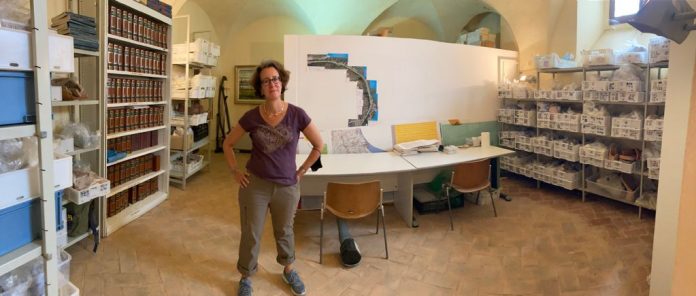
Rebecca Schindler, director of the Honor Scholar program, is currently working on installing a museum in Castiglione del Lago, Italy with her colleagues and DePauw students.
The museum is part of the Trasimeno Regional Archaeological Project (TRAP), a collaboration between DePauw University, the Umbra Institute in Perugia, a study abroad program for American students, and the Comune di Castiglione del Lago in Italy. Established in 2015, the project consists of two parts. One is the field school for American students, where students from DePauw and other institutions take two course credits in archaeology. Another is the research involved in documenting the archaeological sites of Castiglione del Lago and excavating some of those sites.
According to Schindler, there hasn’t been a lot of scientific archaeological excavation in Castiglione del Lago, which is one of the main reasons the team decided to pursue this project. She added that an interesting feature of this territory was that it used to be the land of Estrucan before being taken over by the Roman Empire. “One of our research questions is what does that look like on the ground, like for real people, how do we document that archaeologically,'' Schindler said.
Another focus for the team was the way humans implicated changes to the environment and the topography of the region, which concerned the long-term environmental history of the territory. Accordingly, the team is installing a new museum, which will trace the history of the territory from the prehistoric period to the Roman period based on archaeology and material culture.
Schindler and her colleagues were supposed to start working on the museum in 2020, but they could not go to Italy due to the pandemic. This summer, she made it there to meet with her team and make plans for the space as well as discuss the topics of the exhibitions. Specifically, Schindler “was working primarily on identifying objects from the archaeological excavation that we have conducted that would then go on to display.” The team had to get permission from the Italian Archeological parties to move the objects from the store room into a public space, and make sure that they are conserved properly, so that will be the next stage [in the process], according to Schindler.
The main purpose of the museum, Schindler said, is to “make it accessible for not only the tourists to be able to learn something about the history of the territory but also to make it something that school groups and the local community would be able to use on a regular basis.”
The team is planning to use touch screens where students can view notes and pictures of the archeological sites and 3D printing so that students can interact with the artifacts. “Students can really learn about what archaeology is, and why it is important to excavate sites systematically, to document them,” Schindler said. “That is our hope that we can kind of use our exhibition to actually explain to people how we excavated the site and what we learned while doing that.”
Two dozen DePauw students have been involved with the project from the beginning. “We have students work in a group to actually imagine a display and they have come up with great ideas [for the museum],” Schindler said.
Morgan Stamper 19’ joined the project in the summer before her senior year. She learned about the history and culture of the territory, as well as the archaeological process. But most of her time there was spent at the excavation site in Italy. “It is one thing to look upon a projection… but actually being there and seeing the change between layers, I thought that was really incredible and kind of clicked for me”, Stamper recalled.
In addition to an increased knowledge about archaeology, what she hoped the students would take away from the experience was the ability to communicate why we should care about the past. “The thing that is always hard in any discipline is not only to take the subject matter that you are passionate about and you care about, but also make it accessible to the public,” Schindler said.
Stamper added that what she valued most was the hand-on experience. “To actually see those [artifacts], pull them out of the ground… really helps you figure out what are you working with”, she said. Her main advice for DePauw students pursuing a major and further a career in archaeology was to take the chance and go on such an archeological trip.
Reflecting on the project, Schindler emphasized the responsibility of museums and archeologists regarding culture heritages. She said, “ [Museum visitors] are familiar with traditional kinds of museum exhibitions where you take artifacts, you put them in a case and you put beautiful lighting around them, and as a visitor you are meant to sort of stand there and go ‘that is beautiful.’” But we are at a moment of rethinking the role of museums in society. Museums “can be used to generate public interest in history and in the past, and also in how we think about our places in the present in terms of a longer historical process and how we know that from the archeological record,” Schindler said.
After the museum construction is finished, the team plans to leave a space so as they discover new things about the territory, they can change that space around on a regular basis.


